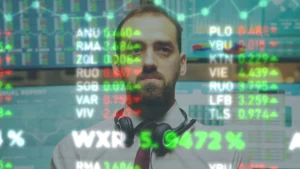The global stock market in 2025 is walking a tightrope between optimism and caution. Recent shifts in volatility have reignited attention on the VIX Index 2025, the widely known “fear gauge” that reflects investors’ expectations of future market swings. This index, which measures volatility based on S&P 500 options, has become a leading barometer for market confidence.
Over the past few months, the VIX Index 2025 has moved sharply higher, signalling growing concern among institutional and retail investors alike. Global inflation, interest rate uncertainty, and geopolitical events have combined to trigger emotional reactions in financial markets. The fear gauge indicator now reflects the rising tension between profit-driven risk-taking and defensive caution.
Yet, rising volatility does not always mean disaster. For investors who understand the patterns behind fear and uncertainty, it can indicate opportunity. The key lies in analysing the VIX Index 2025 within the broader framework of market sentiment analysis. When emotions dominate decision-making, rational strategies tend to outperform.
Understanding the VIX Index 2025 and Its Market Role
The VIX Index 2025 represents the market’s short-term expectation of volatility over the next 30 days. It is calculated using option prices on the S&P 500, reflecting how much traders are willing to pay for protection against market swings. In essence, it measures stock market volatility through collective sentiment rather than raw price action.
When the VIX is low, typically under 15, investors feel confident, and market conditions appear stable. When it climbs above 20, it signals nervousness and heightened risk perception. Readings above 30 often accompany strong market turbulence or economic uncertainty.
Historically, sharp rises in the VIX have coincided with periods of intense investor fear and uncertainty. For example, during the banking sector stress in early 2023, the VIX spiked briefly above 25 as investors anticipated a credit crunch. However, when the crisis stabilised, volatility quickly subsided, and equity prices recovered.
In 2025, similar conditions are emerging. Slower global growth forecasts and concerns about prolonged high interest rates are fuelling renewed anxiety. The fear gauge indicator has risen in response, signalling that traders are paying a premium for downside protection.
Still, it’s essential to remember that the VIX Index 2025 is not a directional forecast. It does not predict whether markets will rise or fall—it only quantifies the level of expected movement. Therefore, a high VIX reflects emotional tension, not guaranteed losses.
The Psychology Behind Stock Market Volatility
To truly understand the VIX Index 2025, investors must grasp the psychology that drives stock market volatility. Financial markets are influenced as much by emotion as by data. When optimism turns to fear, volatility surges, and trading volumes spike.
In times of economic uncertainty, traders buy options to hedge against potential losses. This surge in demand pushes up implied volatility, which lifts the VIX. Conversely, when markets calm down, fewer investors seek protection, causing volatility to fall.
Consider a real-world scenario. When the Federal Reserve in 2024 hinted at delaying rate cuts due to persistent inflation, stock indices briefly tumbled. The VIX Index 2025 jumped from 15 to nearly 22 within days. That movement revealed collective nervousness rather than a change in fundamentals. A month later, as inflation stabilised, the index fell back to pre-announcement levels.
This pattern shows how market sentiment analysis helps explain the connection between human psychology and market behaviour. Short-term panic often distorts long-term logic. Recognising these emotional extremes can help investors anticipate reversals.
For active traders, volatility offers a double-edged sword. High volatility can create losses for those unprepared but opportunities for those who thrive on market movement. Long-term investors, however, often view volatility as noise—a reflection of temporary uncertainty rather than permanent damage.
Why the Fear Gauge Indicator Matters in 2025
The fear gauge indicator has become a core part of every serious trader’s toolkit in 2025. Its importance lies in its ability to quantify sentiment faster than traditional data can capture it. When prices move erratically and headlines dominate investor perception, the VIX acts as a real-time signal of market mood.
Several macroeconomic dynamics make the VIX Index 2025 particularly relevant this year. Inflation remains stubborn in several regions, while energy prices fluctuate due to global supply tensions. Central banks are still walking a fine line between controlling inflation and sustaining growth. Each policy announcement triggers instant reactions across equity and bond markets.
This emotional sensitivity is what the VIX captures. When uncertainty spikes, traders rush to hedge exposure, increasing option demand and pushing the index higher. When stability returns, option prices fall, and the VIX cools down.
The fear gauge indicator serves not just as a panic meter but also as a strategic tool. For instance:
- Long-term investors use it to decide when to rebalance portfolios.
- Short-term traders rely on it to gauge entry and exit timing.
- Risk managers use it to estimate exposure during volatile sessions.
During the first quarter of 2025, the VIX has averaged around 21—slightly above its 10-year mean of 19. This indicates heightened caution but not outright panic. Historically, similar periods have led to positive returns in the following months as fear gradually fades.
How Market Sentiment Analysis Enhances Decision-Making
Effective market sentiment analysis blends quantitative data with behavioural insight. It examines how fear and optimism influence asset prices and identifies when markets deviate from fundamentals. The VIX Index 2025 is a crucial part of this toolkit, allowing analysts to translate emotion into measurable signals.
Sentiment-driven markets often move faster than fundamental news. Traders who monitor the VIX can detect emotional extremes before they appear in stock prices. For instance, if the VIX Index 2025 spikes above 25 but major indices show technical support, that divergence might signal oversold conditions.
Combining the VIX with complementary indicators enhances accuracy. Analysts often track:
- Put-call ratios to assess hedging intensity.
- Volatility term structures to measure future expectations.
- Media tone and search trends to gauge public sentiment.
By integrating these elements, market sentiment analysis gives investors a holistic understanding of risk perception. It also helps prevent overreactions. Instead of following emotional impulses, traders can act based on structured insight.
A clear example occurred during the 2022–2023 tightening cycle. The VIX surged multiple times, yet equities recovered after each spike. Those who studied sentiment data recognised that fear was temporary and positioned accordingly. The same principle applies to the VIX Index 2025—emotional spikes can mark turning points, not trend continuations.
Investor Fear and Uncertainty:
Periods of investor fear and uncertainty have always shaped the rhythm of global markets. Every major crisis in history—from the 2008 financial meltdown to the 2020 pandemic—has followed a predictable emotional curve. Panic rises sharply, volatility spikes, confidence erodes, and then, almost inevitably, recovery begins. In 2025, this pattern remains alive and visible in the behaviour of traders watching the VIX Index 2025.
Understanding Fear as a Market Cycle
Fear isn’t new to investors; it’s a recurring part of every market cycle. During uncertain times, traders sell first and think later. This behaviour causes stock market volatility to rise, pushing the VIX Index 2025 higher. Yet, what appears to be widespread panic is often the prelude to stabilisation.
In 2008, when the global financial system seemed on the verge of collapse, the VIX surged above 80 — the highest level ever recorded. But within 12 months, equity markets staged one of the strongest bull recoveries in modern history. Similarly, in March 2020, at the height of pandemic-driven fear, the VIX again spiked beyond 80. Investors fled risk assets, only to watch them double within a year once vaccines and stimulus programmes restored confidence.
These episodes reveal a crucial truth: fear peaks precede opportunity. Markets overreact to uncertainty but always revert as clarity returns. By 2025, the VIX Index remains well below panic levels, hovering around the low 20s—a zone of cautious sentiment rather than crisis. That means investors are alert, not alarmed, and this emotional balance often supports sustainable recovery.
Modern Drivers of Fear in 2025
Today’s fear stems from new but familiar triggers. Slowing global growth, energy market fluctuations, and uneven technology valuations have all contributed to cautious sentiment. The rise of artificial intelligence, while driving innovation, has also inflated expectations, creating anxiety about bubbles and long-term sustainability.
Investors are adjusting portfolios more frequently as headlines shift between optimism and concern. For many, investor fear and uncertainty are not just reactions to data but reflections of information overload — an environment where every rumour feels like a potential turning point.
How Smart Investors Manage Volatility During Fear
Managing stock market volatility during uncertain periods requires a mix of structure and self-control. Successful investors don’t avoid risk; they manage it intelligently. The following approaches help transform emotional turbulence into strategic advantage:
- Diversify across sectors and asset classes to cushion unexpected drawdowns.
- Maintain exposure to defensive assets such as bonds, gold, or cash during periods of elevated volatility.
- Avoid impulsive trades driven by daily news or market rumours.
- Use stop-loss strategies to prevent small losses from turning into large ones.
- Track historical volatility patterns to identify whether current fear levels are justified or exaggerated.
For example, if the VIX Index 2025 jumps suddenly but trading volume doesn’t confirm widespread selling, it may indicate hedging activity rather than panic liquidation. Recognising that distinction helps investors maintain composure instead of reacting emotionally.
Ultimately, investor fear and uncertainty are temporary reflections of perception, not permanent conditions. Markets tend to overprice risk when anxiety dominates, creating opportunities for contrarian investors who can see through the noise. Those who act rationally when others panic often capture the best entry points.
Turning Volatility into Strategy in 2025
Stock market volatility isn’t a threat—it’s an inevitable and valuable feature of modern investing. The VIX Index 2025acts as the map, showing where emotional extremes exist, but it’s the investor’s strategy that determines the journey. Instead of avoiding volatility, successful traders align it with opportunity, using structured timing, disciplined hedging, and data-driven decision-making.
Using Volatility as a Trading Edge
In 2025, volatility remains elevated across global markets, yet the best investors see this as a trading advantage. Short-term traders often exploit volatility bursts through derivative strategies like straddles, strangles, and spreads, which profit from large price movements regardless of direction. These methods rely on anticipating emotional reactions rather than predicting fundamental outcomes.
For instance, when inflation data surprised markets in late 2024, the VIX Index 2025 jumped to 24. Panic selling followed, but corporate earnings data remained stable. Within six months, major blue-chip companies like Microsoft, Apple, and ExxonMobil regained 10–15% of their lost value. Traders who viewed the volatility spike as an emotional overreaction rather than a structural collapse achieved strong returns.
Meanwhile, long-term investors use volatility differently. Instead of trading daily swings, they accumulate quality assets during temporary market weakness. High volatility pushes strong stocks to attractive valuations, providing long-term buying opportunities. Patience and perspective often outperform speed in uncertain environments.
Recognising Volatility Clusters and Market Phases
Another essential technique is identifying volatility clusters—periods when the VIX remains elevated for weeks. Persistent high readings suggest sustained tension, not just short-term panic. In such conditions, investors can gradually reduce exposure to high-risk assets or rebalance portfolios rather than making abrupt shifts.
Here’s how investors can interpret volatility trends using the VIX Index 2025:
| Market Phase | VIX Behavior | Investor Strategy |
|---|---|---|
| Calm Growth | Below 15 | Accumulate long-term positions |
| Mild Uncertainty | 15–20 | Maintain balanced portfolios |
| Active Volatility | 20–25 | Hedge exposure, tighten stops |
| Fear Zone | 25+ | Prepare for reversals and reentry |
This structured approach transforms stock market volatility into measurable strategy. By studying volatility clusters, investors can detect emotional fatigue—when traders overreact for too long—and position ahead of trend reversals.
Distinguishing Emotional vs. Structural Volatility
Not all volatility is created equal. Emotional volatility comes from news-driven reactions, while structural volatilityarises from fundamental shifts like policy changes or earnings revisions. The VIX Index 2025, when combined with market sentiment analysis, helps traders identify which type dominates.
For example, a sudden VIX spike following a political announcement might fade quickly once details emerge—an emotional event. In contrast, a slow, steady rise in volatility due to economic contraction signals deeper, structural risk. Knowing the difference enables traders to select proper strategies: quick scalps for emotional events and gradual portfolio adjustments for structural trends.
Building a Resilient 2025 Trading Mindset
Beyond tools and charts, success during volatile times depends on psychology. Traders who remain disciplined and patient often outperform those who react impulsively. Viewing volatility as an opportunity fosters confidence rather than fear.
As the VIX Index 2025 continues to reflect global anxiety, investors who master emotional control will stand out. Instead of fearing uncertainty, they’ll recognise that every market fluctuation carries a signal—a chance to enter early, exit smartly, and grow consistently.
In 2025, volatility is not the enemy of progress. It is the pulse of the market itself, and those who learn to read that rhythm turn uncertainty into strategy.
The Road Ahead: What to Expect from the VIX Index in 2025
As 2025 progresses, the trajectory of the VIX Index 2025 will depend on global stability and investor confidence. If central banks succeed in controlling inflation without derailing growth, volatility could ease. However, prolonged geopolitical tension or policy missteps could keep uncertainty elevated.
Current market conditions suggest a moderate-risk environment. Traders remain cautious but opportunistic. The fear gauge indicator may continue to fluctuate within an 18–24 range—reflecting caution without crisis.
For investors, the takeaway is clear: volatility is inevitable but manageable. The VIX Index 2025 should be viewed as a compass, not a crisis alarm. It helps identify when markets are fearful and when optimism may return.
By combining emotional awareness with disciplined strategy, investors can thrive even when uncertainty dominates headlines. The key lies in interpreting volatility as a sign of opportunity rather than weakness.
Frequently Asked Questions
1. What is the VIX Index 2025?
The VIX Index 2025 measures expected U.S. stock market volatility for the next 30 days. It’s based on S&P 500 options and reflects investor sentiment.
2. Why is the VIX called a fear gauge?
It’s called a fear gauge because it rises when investors expect turbulence. A high VIX shows fear, while a low VIX signals confidence.
3. What does a high VIX mean for traders?
A high VIX means markets are nervous. It often signals potential short-term volatility but can also mark the end of panic before recovery begins.
4. What causes volatility to rise in 2025?
Volatility in 2025 is driven by inflation concerns, uncertain rate policies, geopolitical risks, and uneven corporate results—creating investor caution.
5. How can traders use the VIX Index 2025?
Traders use it to gauge fear levels and manage exposure. Rising volatility suggests tightening risk controls, while falling levels show improving confidence.
6. What is a normal VIX range?
A reading between 15 and 20 is typical. Levels above 25 indicate stress, and below 15 reflect calm conditions.
7. How does global volatility compare?
Other regions track similar indexes, like India VIX and VSTOXX in Europe. Together, they show global shifts in market sentiment.
8. Can the VIX predict crashes?
No. The VIX doesn’t predict direction—it reflects expectations. A surge indicates uncertainty, not guaranteed declines.
Read here to learn more about “Gold Bubble 2025 Alert: Traders Brace for Sharp Market Correction“

I’m Chaitali Sethi — a seasoned financial writer and strategist specializing in Forex trading, market behavior, and trader psychology. With a deep understanding of global markets and economic trends, I simplify complex financial concepts into clear, actionable insights that empower traders at every level. Whether it’s dissecting winning strategies, breaking down market sentiment, or helping traders build the right mindset, my content bridges the gap between information and implementation.




